2010 Honda Accord EX vs. 2011 Hyundai Sonata SE, 2010 Subaru Legacy 2.5i
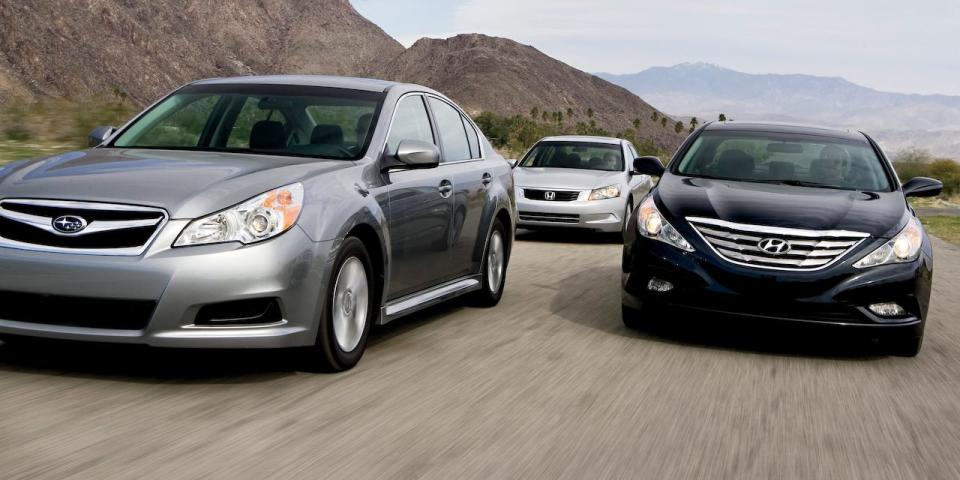
From the May 2010 Issue of Car and Driver
TESTED
For all the ascendance of crossovers—certainly the most amoebic of all automotive classifications—mid-size sedans continue to be one of autodom’s biggest sales categories. There are many reasons for this—all-around family usefulness, resistance to the swollen SUV bulk of crossovers, respectable fuel economy—but double-take glamour is rarely one of them.
This mid-size dedication to stylistic timidity has always mystified us. Given a choice between two implements that function with more or less equal efficiency, wouldn’t you be inclined to pick the one that looks the best? This is not a trick question. As a Detroit design chief observed long ago, “If practicality was all that mattered, they’d have to put a roof over Kalamazoo so they could build enough Checkers to satisfy demand.”
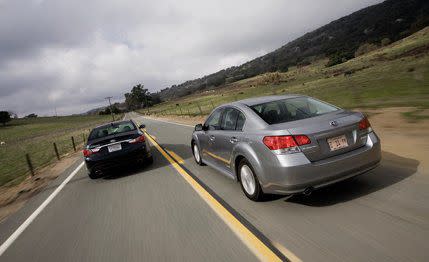
Checker sedans were terrific taxicabs. But their mass-market appeal was limited. Kalamazoo was never in danger of requiring a big roof, and the factory shut down in 1982.
It’s true that several purveyors of mid-size sedans have tried to raise the curbside wattage of recent offerings—the Chevy Malibu, Ford Fusion, Mazda 6, Nissan Altima, and even the Toyota Camry have all snazzed up a couple of notches compared with their predecessors. But how many actually turn heads? Very few; none, maybe. Staying visible in a 15-minutes-of-fame society requires some risk taking. Daring. Chutzpah.
The 2006–’10 Hyundai Sonata played to solid reviews that praised, in particular, its extensive array of standard features and a marked improvement in overall quality. But it’s safe to say that the styling failed to provoke any oohs or aahs. Responses were more of the ho and hum variety.
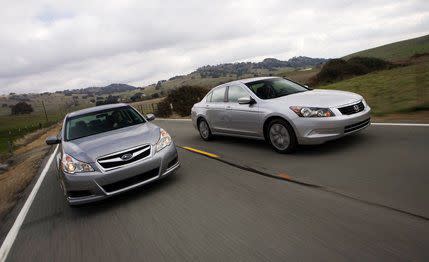
If you’ve been following our previews and show coverage on our website, or if you saw Hyundai’s myriad Super Bowl commercials, you already know that the Sonata, like the ugly duckling, has matured into a handsome swan. If it’s not the sleekest thing in its class, we’d like to know what is.
Of course, looks aren’t everything. If they were, Megan Fox would be president. Or, perhaps even scarier, Sarah Palin. There’s gotta be substance, too, which, in our constituency, translates as supple ride, all-day comfort, decent power, competitive fuel economy, contemporary safety features, high-quality fit and finish, and, of course, a high fun-to-drive quotient.
How does the 2011 Sonata grade out on the full report card? The quickest way to place it in the mid-size-sedan continuum is to pit it against a couple of prominent players in this class. The new Subaru Legacy—redesigned inside and out for 2010—needed to be on the menu since it has yet to be tested against its peer group. And, of course, we had to include the reigning mid-size champ—the Honda Accord, a perennial 10Best Cars titlist (24 trophies in 28 years) and winner of our last three mid-size showdowns.
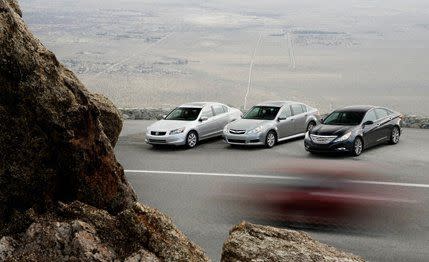
The group’s specifications were constrained by the Sonata’s powertrain limitations. The Accord and the Legacy both offer six-cylinder options, but the new Sonata’s only engine, at least for now, is a naturally aspirated four-cylinder; a manual transmission comes only in the base model. Thus we specified automatics and fours in all three cars—a combination that accounts for a little more than 80 percent of the mid-size, mid-price sedan market.
Our Sonata was the slightly sportier SE model. We requested a midrange Accord EX, and the Legacy was a basic 2.5i with a CVT automatic. Base prices ranged from $20,690 (for the Subaru) to $24,540 (the Honda).
Could one of these newbies knock the Accord off its throne? We assembled our threesome in Southern California to find out.
Although its 2010 redesign saw expansion in every dimension, the Legacy still slots in at the smaller end of the mid-size scale and is the smallest car in this group.
This makes for an intriguing volumetric non sequitur. According to the EPA, the sheetmetal of the Accord and the Sonata surrounds enough interior space to qualify both for “large car” status. Nevertheless, the Subaru has the most rear-seat space and ties the Accord for best rear-seat comfort. And, at 15 cubic feet, its trunk is a little bigger than the Honda’s.
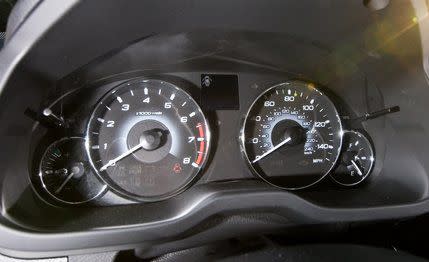
The Legacy’s expert management of inner space is augmented by quality materials, from ceiling to dashboard to attractive cloth upholstery on the seats. Subaru’s interior designers used aluminum-hued plastic trim, a treatment that sounds potentially tacky but looks good on a dashboard layout that’s well organized, with secondary controls that are easy to identify and operate.
Driver comfort is another strong suit. The relaxed-fit front buckets aren’t as supportive as the Honda’s when the cornering loads are high. But they are just fine at an everyday pace, an index bolstered by a slight edge in ride quality among the threesome.
And let us not neglect the Legacy’s value quotient. Like all Subarus, all-wheel drive is standard, as are traction and stability control, ABS, air conditioning, power windows and locks, power mirrors, and an AM/FM/CD audio system. Our 2.5i test car included the optional Premium package (power driver’s seat, 16-inch alloy wheels, auto up/down power driver’s window, leather-wrapped steering wheel, chrome exhaust tip), plus Subaru’s new continuously variable automatic transmission.
But even with $2300 in options, the Legacy’s as-tested price—$22,990—is lower than the base price for both its competitors here. And it also beat the others in observed fuel economy, 25 mpg to 24.
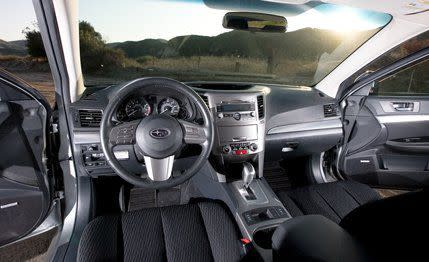
Lots of positives. So what’s the problem? Power, for one. With 170 ponies, the Legacy’s 2.5-liter flat-four has to work hard to generate acceleration in a 3420-pound sedan, heaviest in this group. Yes, the Subaru’s 0-to-60 sprint tied the Honda’s—more on that in a minute—but in the real world, the Legacy feels sluggish. And in any case, 8.7 seconds is more in line with econocar territory, i.e., the Honda Fit.
That velvety ride comes with a downside: lots of rock and roll in hard cornering. And even though the Legacy was tops in our lane-change exercise, its abundant up-and-down body motions, plus skinny 205/60 tires on 16-inch wheels, yielded reluctant corner entries and transient response. All three of these cars understeer, but the Legacy’s resistance to fast cornering made its opponents seem almost neutral. Almost.
We grew weary of the Legacy’s CVT crescendos in hard driving. Its manual, paddle-shift preset ratios mitigated this effect, but the shifts were soft and not satisfying to a crew spoiled by double-clutch automated manuals. A soggy brake pedal, whose travel kept getting longer as the test progressed, didn’t help, either.
In the end, our flogging reinforced the conclusion in our December ’09 test: The Legacy 2.5i stacks up as a solid choice among mid-size sedans—provided you’re not in a hurry.
The last time an Accord and a Sonata were entered in the same tournament [“The Buzzard-and-Baloney Brigade,” March 2008], the Accord prevailed and the Sonata finished fourth (of seven). But here we are, just two years later, and the Sonata has unseated a car we generally regard as the best of a very competitive class. It’s also the first Hyundai to claim top honors in a mainstream C/D comparo. (An Elantra wagon won out over a Suzuki Esteem and a Daewoo Nubira 11 years ago [“Wee Wagons,” October 1999]). As upsets go, this may not rival the Royal Air Force turning back the Luftwaffe in 1940. But it’s a landmark for a Korean carmaker that didn’t even exist before 1967.
So how can this be?
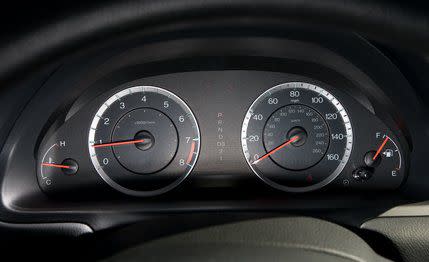
As a mitigating point, when our Accord rolled onto the test track for instrumented evaluation, there were just 150 miles on the odometer—a seriously “green” engine, which we feel certain cost the Honda a tenth or three in the acceleration runs. As the miles piled up in succeeding days, the Accord’s throttle responses became noticeably livelier, emitting a satisfying snarl in the process—but by then, of course, the instrumented acceleration runs were history.
The Accord had its innings. Although the Sonata has a distinct edge in power, and its six-speed auto (versus the Accord’s five-speed) makes the most of it, the Honda was the champ on mountain roads, attacking decreasing-radius turns and quick transitions with a certainty the Hyundai couldn’t quite match. Though the Honda was the biggest car in the group, its agility belied its dimensions, lane-change results notwithstanding.

This also applies to braking. The Accord’s 70-to-0 stops were the poorest—all the results were diminished by a dusty test track—but its brakes showed no hint of excess heat or fade in two days of mountain workouts. Does all this dynamic hairsplitting really matter in a family sedan? Maybe not. Then again, there could be an emergency situation when it does matter.
Comfort is another Accord advantage. Its front seats are better bolstered than those in the supposedly sportier Sonata; the cloth upholstery is grippier; there’s more rear-seat headroom; and the Honda is the only car in the group with rear-seat A/C outlets, a welcome feature in the desert.
Interior materials are also top-notch, although it is hard to appreciate this, given the Honda’s stygian monochromatic décor. Boring—a word that also applies to the Accord’s exterior.
In addition to hard-to-ignore good looks, the new Sonata is also bigger than its predecessor: 189.8 inches long (versus 188.9) on a 110.0-inch wheelbase, a stretch of 2.6 inches. Width is essentially unchanged, at 72.2 inches, as is height (57.9), although the roofline slopes away faster from the B-pillars aft. Though the dimensions have expanded, the turning circle has remained the same—just 35.8 feet, according to Hyundai, tidiest among the major players in this segment.
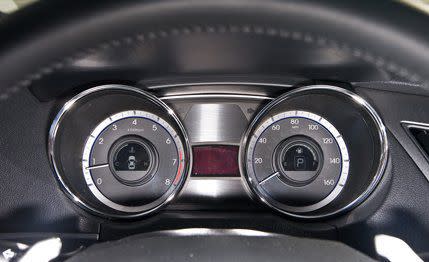
Hyundai claims the new unibody represents gains of 25 and 19 percent, respectively, in torsional and bending rigidity, and if the Sonata is any less stiff than the Accord, it’s hard to detect by one’s gluteal meter. The doors close with that nicely damped thunk that sounds like quality, and the interior is quiet in most operating modes, though at full-tilt-boogie, the engine begins sounding a bit thrashy.
The Sonata’s 2.4-liter, DOHC 16-valve four is the first in its class to be fed by direct injection, with variable valve timing on both cams. It’s rated for 198 horsepower and 184 pound-feet of torque in base (GLS) and top-of-the-line Limited models, 200 ponies in the SE version, thanks to its dual exhaust. If 200 horsepower doesn’t seem sufficient, there’s a turbo version—“more than 250 horsepower,” according to Hyundai—due this fall, as well as a hybrid.
Limiting the Sonata to four-cylinder power allowed the design team to optimize componentry for the lighter engine, which, in turn, added up to reduced curb weights. In our test car, this was 3340 pounds—only 20 pounds less than the Accord, but the Sonata also had the most features, which swelled the total.
In addition to output that’s stout for a naturally aspirated four-banger, Hyundai’s new engine is also capable of a high thrift index—22 mpg city (24 with the manual), 35 highway, according to the EPA. As noted earlier, we didn’t do quite that well: 24 mpg for our 400-mile tour.
A six-speed manual transmission is standard in the GLS (from $19,915) but not in the upmarket models, which send power to the front wheels via a new six-speed automatic engineered and produced by Hyundai.
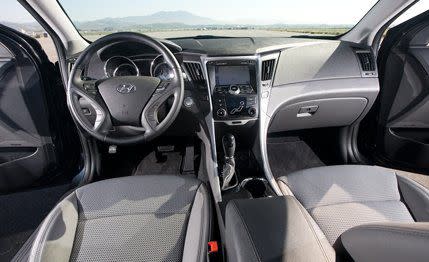
The absence of a manual transmission in the sporty model seems peculiar. However, the SE does have a set of paddle shifters affixed to the steering wheel. Up- and downshift response time is relaxed, as are passing kickdowns when in drive, but, generally speaking, Hyundai’s new homegrown gearbox is a smooth operator.
Smooth also applies to ride quality, and if the Sonata isn’t quite as athletic as the Accord, the distinction is subtle.
Look at the accompanying charts and you’ll see that the Sonata won nearly every objective category. And, as also indicated, it wins flat-out for style. Created at the Hyundai Design & Research Center in California, the sleek shape suggests motion even when it’s parked, thanks to that fast roofline, down-swooping character line running from the taillamp to the front fender well, and a chrome spear extending along the beltline all the way to the headlamp cluster.
We’ve heard suggestions that this shape—“fluidic sculpture design,” in Hyundese—is little more than a knockoff of the more expensive Volkswagen CC, but this seems invidious. The Sonata design was undoubtedly largely locked in by the time the CC hit the show circuit, and, in any case, both cars owe at least some inspiration to the earlier Mercedes CLS.
The interior, which was designed in Korea, is equally classy, as well as bright, at least in this SE model, with its attractive gray-and-black cloth upholstery, vacuum-fluorescent instruments, and HVAC controls that require only the quickest of glances to interpret and operate.
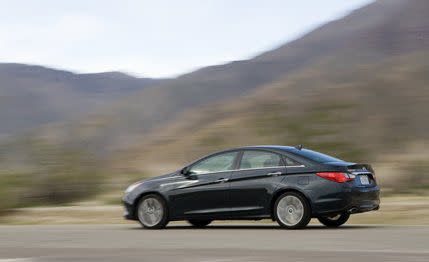
We wish the bucket seats provided more lateral support and that the rear-seat cushions weren’t quite so flat and quite so hard. More than one of our crew wished the telescoping steering column offered an inch or two more of travel. And the sloping roofline limits rear-seat headroom—tall-in-the-saddle passengers won’t be happy back there.
Nevertheless, these are lesser demerits in a car that gladdens the eye. As one of our test drivers observed, the Sonata “definitely feels half a class above its price tag.”
You might object that the Sonata was the most expensive car in this test. But that as-tested price includes a $2600 option package—navigation, power tilt/slide sunroof, and premium audio. A similarly equipped Accord would cost $29,540. And the Sonata also includes an exceptionally long list of standard features, a typical Hyundai marketing procedure.
Stir in standout styling, and it adds up to a winning recipe. Is the Sonata the new mid-size benchmark? Well, it’s clearly moved into the front rank. And it’s equally clear that the answer to the thesis question—does styling matter in a mid-size sedan?—is yes.
You Might Also Like

 Yahoo Autos
Yahoo Autos 